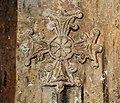Nestorianism is a term used in Christian theology and Church history to refer to several mutually related but doctrinarily distinct sets of teachings. The first meaning of the term is related to the original teachings of Christian theologian Nestorius, who promoted specific doctrines in the fields of Christology and Mariology. The second meaning of the term is much wider, and relates to a set of later theological teachings, that were traditionally labeled as Nestorian, but differ from the teachings of Nestorius in origin, scope and terminology. The Oxford English Dictionary defines Nestorianism as "The doctrine of Nestorius, patriarch of Constantinople, by which Christ is asserted to have had distinct human and divine persons."

The Daqin Pagoda is a Buddhist pagoda in Zhouzhi County of Xi'an, Shaanxi Province, China, located about two kilometres to the west of Louguantai temple. The pagoda has been claimed as a Church of the East from the Tang dynasty.

The Assyrian Church of the East (ACOE), sometimes called the Church of the East and officially known as the Holy Apostolic Catholic Assyrian Church of the East (HACACE), is an Eastern Christian church that follows the traditional Christology and ecclesiology of the historical Church of the East. It belongs to the eastern branch of Syriac Christianity, and employs the Divine Liturgy of Saints Addai and Mari belonging to the East Syriac Rite. Its main liturgical language is Classical Syriac, a dialect of Eastern Aramaic, and the majority of its adherents are ethnic Assyrians.
The Xi'an Stele or the Jingjiao Stele, sometimes translated as the "Nestorian Stele," is a Tang Chinese stele erected in 781 that documents 150 years of early Christianity in China. It is a limestone block 279 centimetres high with text in both Chinese and Syriac describing the existence of Christian communities in several cities in northern China. It reveals that the initial Church of the East had met recognition by the Tang Emperor Taizong, due to efforts of the Christian missionary Alopen in 635. According to the stele, Alopen and his fellow Syriac missionaries came to China from Daqin in the ninth year of Emperor Taizong (635), bringing sacred books and images. The Church of the East monk Adam composed the text on the stele. Buried in 845, probably during religious suppression, the stele was not rediscovered until 1625. It is now in the Stele Forest in Xi'an.
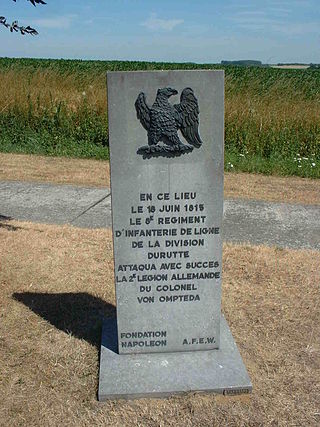
A stele, or occasionally stela, when derived from Latin, is a stone or wooden slab, generally taller than it is wide, erected in the ancient world as a monument. The surface of the stele often has text, ornamentation, or both. These may be inscribed, carved in relief, or painted.

Alopen is the first recorded Assyrian Christian missionary to have reached China, during the Tang dynasty. He was a missionary from the Church of the East, and probably a Syriac speaker from the Sasanian Empire or from Byzantine Syria. He is known exclusively from the Xi'an Stele, which describes his arrival in the Tang capital of Chang'an in 635 and his acceptance by Emperor Taizong of Tang. His is the earliest known name that can be attached to the history of the Church of the East in China.

The Church of the East historically had a presence in China during two periods: first from the 7th through the 10th century in the Tang dynasty, when it was known as Jingjiao, and later during the Yuan dynasty in the 13th and 14th centuries, when it was described alongside other foreign religions like Catholicism and possibly Manichaeism as Yelikewen jiao.
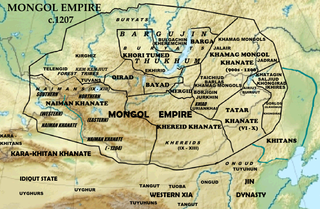
The Ongud were a Turkic tribe that later became Mongolized active in what is now Inner Mongolia in northern China around the time of Genghis Khan (1162–1227). Many Ongud were members of the Church of the East. They lived in an area lining the Great Wall in the northern part of the Ordos Plateau and territories to the northeast of it. They appear to have had two capitals, a northern one at the ruin known as Olon Süme and another a bit to the south at a place called Koshang or Dongsheng. They acted as wardens of the marches for the Jin dynasty (1115–1234) to the north of Shanxi.

The Azure Dragon, also known as Qinglong in Chinese, is one of the Dragon Gods who represent the mount or chthonic forces of the Five Regions' Highest Deities. It is also one of the Four Symbols of the Chinese constellations, which are the astral representations of the Wufang Shangdi. The Azure Dragon represents the east and the spring season. It is also sometimes referred to as the Blue-green Dragon, Green Dragon, or the Blue Dragon.
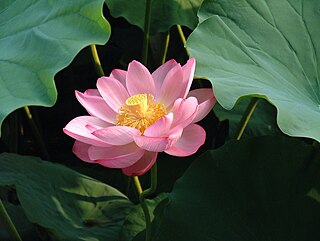
The lotus, Nelumbo nucifera, is an aquatic plant that plays a central role in the art of Indian religions such as Hinduism, Buddhism, Jainism and Sikhism.

In modern times the Mongols are primarily Tibetan Buddhists, but in previous eras, especially during the time of the Mongol empire, they were primarily shamanist, and had a substantial minority of Christians, many of whom were in positions of considerable power. Overall, Mongols were highly tolerant of most religions, and typically sponsored several at the same time. Many Mongols had been proselytized by the Church of the East since about the seventh century, and some tribes' primary religion was Christian. In the time of Genghis Khan, his sons took Christian wives of the Keraites, and under the rule of Genghis Khan's grandson, Möngke Khan, the primary religious influence was Christian.
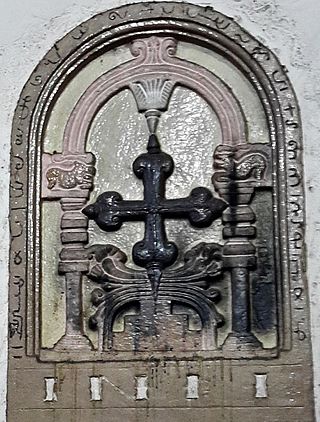
Mar Thoma Sleeva (Saint Thomas Cross) ancient crosses associated with the community of Indian subcontinent, who trace their origins to the evangelism of Thomas the Apostle in the 1st century AD. The Saint Thomas Christians, which is one of the oldest Christian communities of the world, survive in the Malabar region in state of Kerala, India and have a diaspora in other parts of the Indian subcontinent. Saint Thomas Christian crosses are known as Mar Thoma Sleeva (Saint Thomas cross), Indian cross, or Persian Cross in English, as well as Nasrani Sthambam in Malabarese.

Yunju Temple is a Buddhist temple located in Fangshan District, 70 kilometers (43 mi) southwest of Beijing and contains the world's largest collection of stone Buddhist sutra steles. Yunju Temple also contains one of only two extant woodblocks for the Chinese Buddhist Tripitaka in the world as well as rare copies of printed and manuscript Chinese Buddhist Tripitakas. It also has many historic pagodas dating from the Tang and Liao Dynasty.

The Church of the East or the East Syriac Church, also called the Church of Seleucia-Ctesiphon, the Persian Church, the Assyrian Church, the Babylonian Church or the Nestorian Church, was an Eastern Christian church of the East Syriac Rite, based in Mesopotamia. It was one of three major branches of Eastern Christianity that arose from the Christological controversies of the 5th and 6th centuries, alongside the Oriental Orthodox Churches and the Chalcedonian Church. During the early modern period, a series of schisms gave rise to rival patriarchates, sometimes two, sometimes three. Since the latter half of the 20th century, three churches in Iraq claim the heritage of the Church of the East. Meanwhile, the East Syriac churches in India claim the heritage of the Church of the East in India.

The Anuradhapura cross is a form of the Christian cross symbol. It is the most ancient symbol of Christianity in Sri Lanka.

The Mogao Christian painting, also known as Painting of a Christian figure or Fragment of a Christian figure, is a fragmentary silk painting of a haloed man with crosses on his head and chest who has been interpreted as a Christian figure associated with the Church of the East. The painting dates to the end of the 9th century, during the Guiyi rule of Dunhuang under the Zhang family. It was discovered by the Hungarian-born British archaeologist Aurel Stein at the Library Cave of the Mogao Caves in 1908, and is now kept in the British Museum, London.

The murals from the Christian temple at Qocho are three Church of the East mural fragments—Palm Sunday, Repentance and Entry into Jerusalem—discovered by the German Turpan expedition team, which was led by two German archaeologists Albert Grünwedel and Albert von Le Coq, in the early 20th century.

The Manichaean Painting of the Buddha Jesus (Chinese: 夷數佛幀; pinyin: Yí shù fó zhēn; Wade–Giles: I2-shu4 fo2-chên1; Japanese: キリスト聖像; rōmaji: Kirisuto Sei-zō; "Sacred Image of Christ"), is a Chinese Southern Song dynasty silk hanging scroll preserved at the Seiunji Temple in Kōshū, Yamanashi, Japan. It measures 153.5 cm in height, 58.7 cm in width, dates from the 12th to 13th centuries, and depicts a solitary nimbate figure on a dark-brown medieval Chinese silk. According to the Hungarian historian Zsuzsanna Gulácsi, this painting is one of the six documented Chinese Manichaean hanging scrolls from Zhejiang province from the early 12th century, which titled Yishu fo zhen (lit. "Silk Painting of the Buddha [Prophet] Jesus").

The Nestorian pillar of Luoyang is a Tang Chinese pillar erected in 814–815 CE, which contains inscriptions related to early Christianity in China, particularly the Church of the East. It is a Nestorian pillar, discovered in 2006 in Luoyang, which is related to the Xi'an Stele.
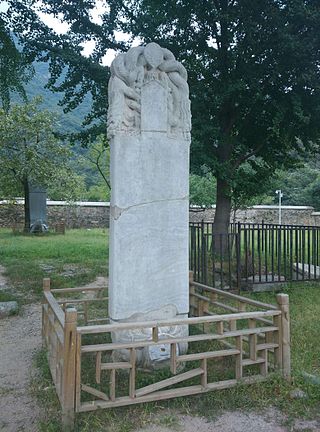
The Cross Temple was a place of worship in Fangshan District, Beijing. During different time periods in history, it was used by Buddhists and the Church of the East in China, a Nestorian Christian sect known as Jingjiao (景教) in Chinese. It is the only remaining site of the Church of the East in China.













